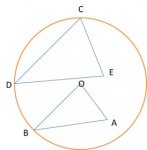You are using an out of date browser. It may not display this or other websites correctly.
You should upgrade or use an alternative browser.
You should upgrade or use an alternative browser.
central angle and inscribed angle
- Thread starter bdia
- Start date
HallsofIvy
Elite Member
- Joined
- Jan 27, 2012
- Messages
- 7,763
Yes, to both of those. Extending or limiting the lines representing the sides of the angle (technically the sides of an angle must be rays that extend to infinity) does not change the angle itself.
Generally, the definitions I have seen always refer to the end points (B & A in this case) as being on the circumference of the circle, i.e. something like 'Central angles are angles formed by any two radii in a circle.' Thus, although the angle would be the same, BOA would not be called a central angle in this case. Similarly with angle DCE.hi ..
i want to know if we can call the angle BOA central angle or not ;becouse if we extend the line OA to become radius it will be central angle
and the same on the inscribed angle DCE ;if we extend the line CE to become chord it will be inscribed angle .
Since man is a rationalizing animal, one might consider that central angles are associated with circles and thus end points for central (and inscribed) angles must be attached to the circle.
pka
Elite Member
- Joined
- Jan 29, 2005
- Messages
- 11,971
bdia;367751i want to know if we can call the angle BOA central angle or not ;becouse if we extend the [COLOR=#ff0000 said:line OA to become radius[/COLOR] it will be central angle and the same on the inscribed angle DCE ;if we extend the line CE to become chord it will be inscribed angle .
I realize that you may have not been taught correct geometric vocabulary, but "line OA to become radius" is incorrect. Radius is a number. A radial segment is a line segment from the center of a circle to a point of the circle, the length of a radial segment is the radius if the circle.
If \(\displaystyle A'\) is on the circle such that \(\displaystyle \overline {OA} \subset \overline {OA'} \) then \(\displaystyle \angle BOA'\) is a central algle.
If \(\displaystyle E'\) is on the circle such that \(\displaystyle \overline {DE} \subset \overline {DE'} \) then \(\displaystyle \angle CDE'\) is a central algle.
I realize that you may have not been taught correct geometric vocabulary, but "line OA to become radius" is incorrect. Radius is a number. A radial segment is a line segment from the center of a circle to a point of the circle, the length of a radial segment is the radius if the circle.
If \(\displaystyle A'\) is on the circle such that \(\displaystyle \overline {OA} \subset \overline {OA'} \) then \(\displaystyle \angle BOA'\) is a central algle.
If \(\displaystyle E'\) is on the circle such that \(\displaystyle \overline {DE} \subset \overline {DE'} \) then \(\displaystyle \angle CDE'\) is a central algle.
Thank you for the correction, i don't know the correct geometric vocabulary.Currently I'm learning and trying to use the vocabulary correctly.
I did an Activity yesterday at the school for the central angle, through the explanation of it i gave them example for not central angle , one side is radius and the other is not radius, but my teacher interrupted me and told me like what you said.But I wasn't convinced; becouse there are condition to become central angle ..
I see nothing wrong with saying that any 2 straight lines with different slopes
that meet at center of a circle create a central angle.
Is there a chance I'll be immortalized for such an astute statement
im-mor-tal-ize
[ih-mawr-tl-ahyz]
-to bestow unending fame upon; perpetuate.
Yes, there is.
This is a summary of the central angle definition.
Thank you!
I see nothing wrong with saying that any 2 straight lines with different slopes
that meet at center of a circle create a central angle.
Is there a chance I'll be immortalized for such an astute statement
im-mor-tal-ize
[ih-mawr-tl-ahyz]
-to bestow unending fame upon; perpetuate.
I don't see anything wrong with saying that either. However, most, if not all, definitions I have seen do mention, in some fashion or another, that the end points are on the circumference of the circle. Oh, and Denis, how a central angle of zero? Wouldn't the lines have the same slope? [and just because all would see is the single line, doesn't mean the other isn't there]
In addition, if some instructor wants to define a central (and inscribed) angle in that fashion, then I think the instructor should make it clear the end points don't have to be on the circumference of the circle as, possibly, bdia's teacher did not initially.

